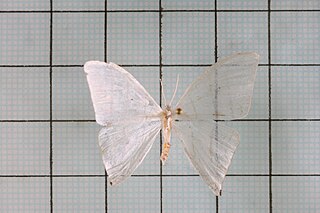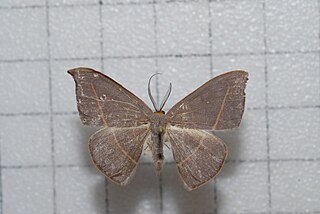Phalga is a genus of moths of the family Euteliidae. The genus was erected by Moore in 1881.
Varmina is a monotypic moth genus in the subfamily Lymantriinae described by Frederic Moore in 1888. Its only species, Varmina indica, was first described by Francis Walker in 1855. It is found in the East Indies.
Allaxitheca is a monotypic moth genus in the family Geometridae described by Warren in 1897. Its only species, Allaxitheca purpurascens, was first described by Frederic Moore in 1888.

Ditrigona is a genus of moths belonging to the subfamily Drepaninae. The genus was erected by Frederic Moore in 1888.

Microblepsis is a genus of moths belonging to the subfamily Drepaninae.

Nordstromia is a genus of moths belonging to the subfamily Drepaninae.
Zusidava is a genus of moths belonging to the subfamily Drepaninae.

Chandica quadripennis is a moth of the family Nolidae first described by Frederic Moore in 1888. It is found in the Himalayas, Peninsular Malaysia, Sumatra and Borneo.

Epipsestis is a genus of moths belonging to the subfamily Thyatirinae of the Drepanidae. It was erected by Shōnen Matsumura in 1921.

Stericta is a genus of snout moths. It was described by Julius Lederer in 1863.
Eois plicata is a moth in the family Geometridae. It is found in India.
Agnibesa recurvilineata is a moth in the family Geometridae first described by Frederic Moore in 1888. It is found in Darjeeling in India, in western China and Nepal.
Asura calamaria is a moth of the family Erebidae first described by Frederic Moore in 1888. It is found in from the north-eastern Himalayas to Sundaland, including Myanmar. The habitat consists of disturbed forests, including disturbed alluvial forests and remnants of primary montane forests.
Nordstromia simillima is a moth in the family Drepanidae. It was described by Frederic Moore in 1888. It is found in Kashmir in what was north-western British India.
Microblepsis prunicolor is a moth in the family Drepanidae. It was described by Frederic Moore in 1888. It is found in north-eastern India, Sikkim, north-eastern Myanmar and possibly China.
Paralbara perhamata is a moth in the family Drepanidae. It was described by George Hampson in 1892. It is found in Northeast India including Sikkim and in Borneo.
Ditrigona pruinosa is a moth in the family Drepanidae. It was described by Frederic Moore in 1888. It is found in Darjeeling, India. The Global Lepidoptera Names Index lists it as a synonym of Ditrigona quinaria.
Zusidava tortricaria is a moth in the family Drepanidae. It was described by Francis Walker in 1863. It is found on Borneo.





